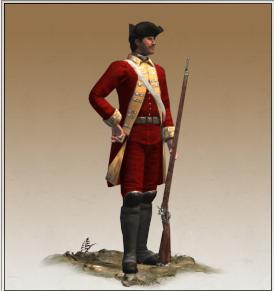Line Infantry (ETW Unit)
Line Infantry
Unit Description
These musket-armed troops use massed volleys to break an enemy, relying on discipline to withstand any counter fire.
"Marching regiments" and "line battalions" make up the majority of units in European-style armies. They are so called because they form the lines of battle, not because they always deploy in lines. Indeed, over time the capabilities of line infantry should improve as new tactics, drills and weaponry are developed.
These soldiers carry muzzle-loading,smoothbore muskets firing lead balls as wide as a man's thumb. These innacurate weapons, effective only over 200 yards or so and when fired in massed volleys. The ability to fire and reload with machine-like regularity with shot and bullets flying and comrades falling all aroung is what wins battles.
Historically, in many armies colonels recieved a fee to raise regiments, which remained their personal property and commands. They jealously guarded thier right to appoint friends, relatives and hangers-on as regimental officers. This contractor system, however, allowed unscrupulous offiers to make handsome profits by pocketing the pay of non-existent soldiers. the better colonels did take a pride in their regiments, spending their fortunes on good uniforms and weapons. the capabilities of a "standard" line infantry unit therfore varied between nations and over time. It wasn't until the 1760's that anything approaching uniformity of drill, equipment and regulations became the norm.
Line infantry regiments remained unchanged throughout the period, and their organisational patterns still form the basis of modern military units.
Factional Differences
Britain's line infantry reload faster and has both better morale and better defense statistics than than most other factions.
Austria has more line infantry per unit but it is of poorer quality.
Tactics
Enter your tactics and strategies here!
